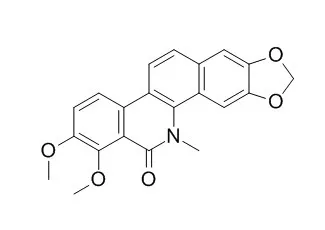| In vitro: |
| Industrial Crops & Products, 2015 , 74 :407-11. | | Antifeedant activities of methanol extracts of four Zanthoxylum species and benzophenanthridines from stem bark of Zanthoxylum schinifolium against Tribolium castaneum[Reference: WebLink] |
METHODS AND RESULTS:
Antifeedant activities of the methanol extracts from Zanthoxylum bungeanum, Zanthoxylum schinifolium, Zanthoxylum armatum and Zanthoxylum dissitum were assessed on Tribolium castaneum adults. It was found that the methanol extract of stem bark of Z. schinifolium had the highest antifeedant activity at 41.12% (antifeedant index). Based on bioactivity-guided fractionation, six benzophenanthridines norchelerythrine (1), decarine (2), 8-hydroxy-9-methoxy-2,3-(methylenedioxy) benzophenanthridine (3), 6-hydroxydihydrochelerythrine (4), 6-methoxy-7-hydroxydihydrochelerythrine (5) and Oxychelerythrine (6) were isolated from the stem barks of Z. schinifolium. And their antifeeding activities were also evaluated against T. castaneum.
CONCLUSIONS:
All of them exhibited strong antifeeding activity in a concentration-dependant manner with EC50 of 62.67, 66.97, 151.39, 96.72, 141.61 and 192.32 ppm, respectively. The six bioactive compounds from the stem bark of Z. schinifolium might be used as antifeedants against T. castaneum. | | Phytomedicine. 2015 Apr 15;22(4):469-76. | | Enhancing activity of antibiotics against Staphylococcus aureus: Zanthoxylum capense constituents and derivatives.[Pubmed: 25925969] | Six compounds (1-6), isolated from the methanol extract of the roots of the African medicinal plant Zanthoxylum capense Thunb. (Rutaceae), and seven ester derivatives (7-13) were evaluated for their antibacterial activities and modulatory effects on the MIC of antibiotics (erythromycin, oxacillin, and tetracycline) and ethidium bromide (EtBr) against a Staphylococcus aureus reference strain (ATCC 6538).
METHODS AND RESULTS:
Using the same model, compounds 1-13 were also assessed for their potential as efflux pump inhibitors by a fluorometric assay that measures the accumulation of the broad range efflux pump substrate EtBr. Compounds 8 and 11 were further evaluated for their antibacterial, modulatory and EtBr accumulation effects against four additional S. aureus strains, which included two clinical methicillin-resistant S. aureus (MRSA) strains. Compounds (1-13) have not shown antibacterial activity at the concentration ranges tested. When evaluated against S. aureus ATCC 6538, Oxychelerythrine (1) a benzophenanthridine alkaloid, showed the highest modulatory activity enhancing the susceptibility of this strain to all the tested antibiotics from two to four-fold. Ailanthoidiol diacetate (8) and ailanthoidiol di-2-ethylbutanoate (11) were also good modulators when combined with EtBr, increasing the bacteria susceptibility by four and two-fold, respectively. In the EtBr accumulation assay, using ATCC 6538 strain, the phenylpropanoid (+)-ailanthoidiol (6) and most of its ester derivatives (8-11) exhibited higher activity than the positive control verapamil. The highest effects were found for compounds 8 and 11 that also increased the accumulation of EtBr, using S. aureus ATCC 25923 as model. Furthermore, both compounds (8, 11) were able to enhance the ciprofloxacin activity against the MRSA clinical strains tested, causing a reduction of the antibiotic MIC values from two to four-fold. The EtBr accumulation assay revealed that this modulation activity was not due to an inhibition of efflux pumps mechanism.
CONCLUSIONS:
These results suggested that Z. capense constituents may be valuable as leads for restoring antibiotic activity against MRSA strains. |
|






 Cell. 2018 Jan 11;172(1-2):249-261.e12. doi: 10.1016/j.cell.2017.12.019.IF=36.216(2019)
Cell. 2018 Jan 11;172(1-2):249-261.e12. doi: 10.1016/j.cell.2017.12.019.IF=36.216(2019) Cell Metab. 2020 Mar 3;31(3):534-548.e5. doi: 10.1016/j.cmet.2020.01.002.IF=22.415(2019)
Cell Metab. 2020 Mar 3;31(3):534-548.e5. doi: 10.1016/j.cmet.2020.01.002.IF=22.415(2019) Mol Cell. 2017 Nov 16;68(4):673-685.e6. doi: 10.1016/j.molcel.2017.10.022.IF=14.548(2019)
Mol Cell. 2017 Nov 16;68(4):673-685.e6. doi: 10.1016/j.molcel.2017.10.022.IF=14.548(2019)